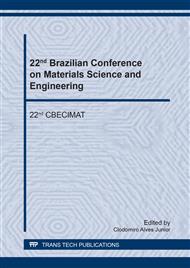p.254
p.258
p.264
p.270
p.276
p.283
p.293
p.299
p.305
Influence of the Geometric Characteristics of the Mini-Implants on Mechanicals Properties Using Artificial Bone Similar to Anterior, Middle and Posterior Regions of the Jaws
Abstract:
The objective of this study was to identify the best torque of insertion and removal of mini-implants with a twin screw design (compact and self-drilling) into artificial bones with density and trabecular thickness, similar to anterior, middle and posterior regions of the jaws. Observation of the mini-implants surface using electron microscopy was performed before and after the tests. The torque values obtained during the insertion and removal was measured by digital torque wrench. The analyzed results led to the conclusion that the insertion and removal torques were larger with increase in bone density and cortical thickness. The design of the threads of the mini-implants influenced the insertion torque. Threads with smaller pitch increased the value of insertion torque. The anterior bone drilling installation reduces the insertion torque independent of bone density. Torque increased mainly by increasing the bone density and not necessarily with increased cortical thickness suggesting that the bone density of the trabecular bone must be considered in designing the installation of mini-implants.
Info:
Periodical:
Pages:
276-282
Citation:
Online since:
September 2018
Authors:
Keywords:
Price:
Сopyright:
© 2018 Trans Tech Publications Ltd. All Rights Reserved
Share:
Citation:


